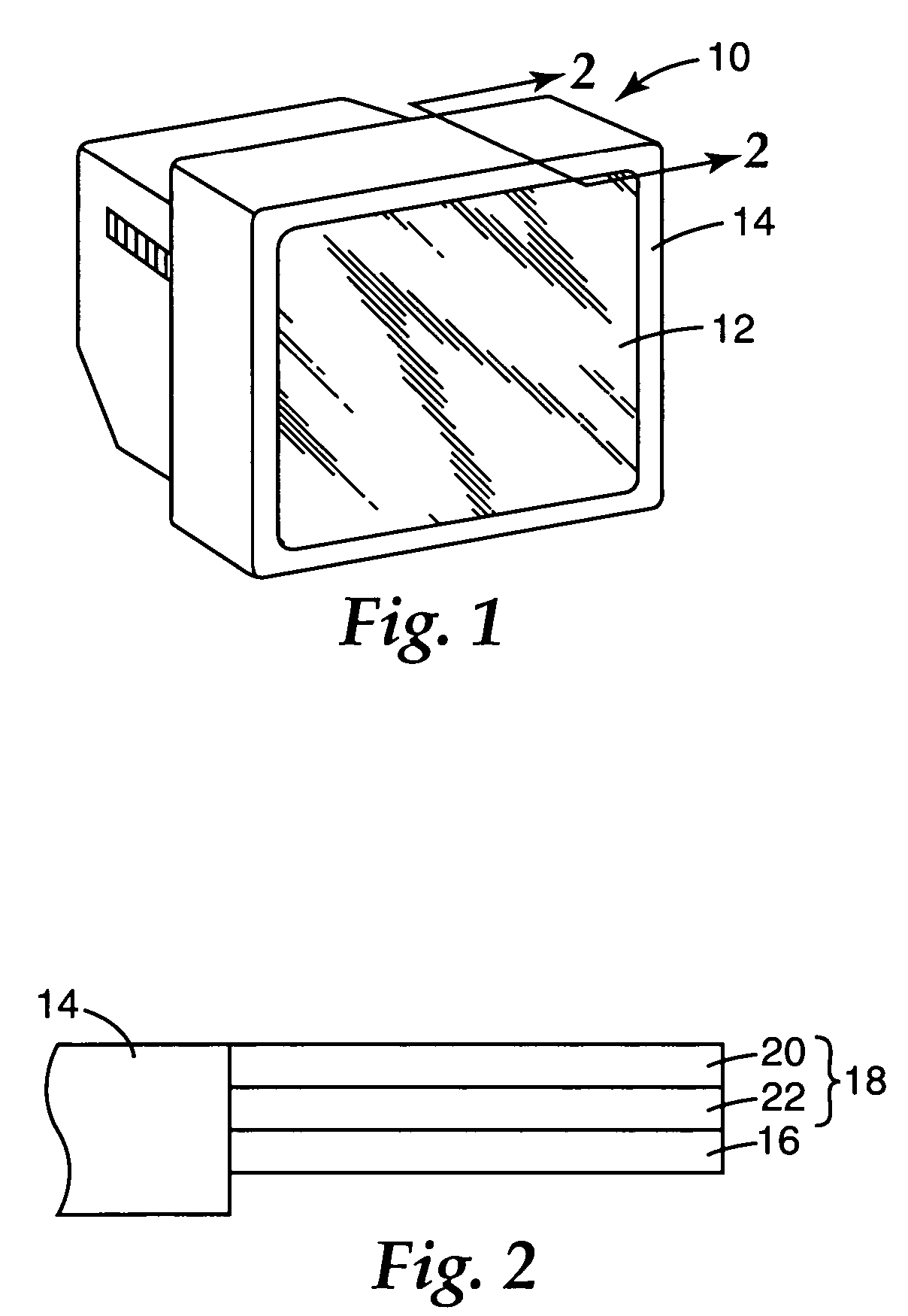Low refractive index fluoropolymer coating compositions for use in antireflective polymer films
a technology of anti-reflection polymer and coating composition, which is applied in the field of anti-reflection films, can solve the problems of reducing the surface energy of the coating layer, reducing the interfacial adhesion of the fluoropolymer layer to other polymer or substrate layers to which the layer is attached,
- Summary
- Abstract
- Description
- Claims
- Application Information
AI Technical Summary
Benefits of technology
Problems solved by technology
Method used
Image
Examples
examples
[0091] The following paragraphs illustrate, via a specific set of example reactions and experimental methodologies, the improvements of each of the component steps for forming the low refractive index composition of the present invention. The paragraphs detail test methods, ingredients, and experimental tests done to confirm the improvements of each component step.
A. Test Methods
1. Peel Strength
[0092] A peel strength was used to determine interfacial adhesion. To facilitate testing of the adhesion between the layers via a T-peel test, a thick film (20 mil (0.51 mm)) of THV 220 or FC 2145 was laminated onto the side of the films with the fluoropolymer coating in order to gain enough thickness for peel measurement. In some cases, a slight force was applied to the laminated sheet to keep a good surface contact. A strip of PTFE fiber sheet was inserted about 0.25 inch (0.64 mm) along the short edge of the 2 inch×3 inch (5.08 cm×7.62 cm) laminated sheet between the substrate surface...
example set 1
Interfacial Adhesion Improvement Between Fluoropolymers and Substrates
[0131] Dyneon™ Fluoroplastic THV™ 220, Dyneon™ fluoroelastomer FC-2145 or brominated fluoroelastomer E-15742 were each dissolved individually in containers with either MEK or ethyl acetate at 5 weight percent by shaking at room temperature. The prepared fluoropolymer solutions were then combined with an aminosilane / methanol solution, such as 3-aminopropyltrimethoxysilane (or A1106 in methanol) in various ratios. The solids were diluted to 3% solids in Methyl ethyl ketone and coated on the substrate with a #3 Meyer Rod. The mixed fluoropolymer / aminosilane solutions were applied to S1 or S2. This gave a calculated dry coating thickness of approximately 100 nm. The coated films were dried briefly, then subjected to heating at 100-120° C. for 10 minutes.
[0132] Subsequently the films were further subjected to UV irradiation by H-bulb or by a 254 nanometer (nm) lamp, or simply subjected to heat, or thermal and UV comb...
example set 2
Photocrosslinking / Photografting of Fluoropolymers
[0134] The above prepared fluoropolymer solutions in Example 1 were combined with one or more crosslinkers as shown in Table 7. The various compositions of coating solutions were allowed to sit in an airtight container. The solutions were then applied as a wet film to (S1) or (S2) in the same manner as described for Example Set 1. The coated films were dried in an oven at 100-120° C. for 10 minutes.
[0135] Subsequently the films were subjected to UV (H-bulb) irradiation by 3 passes at the speed of 35 feet per minute. Alternatively, the films were subjected to UV irradiation from a 254-nanometer (nm) bulb using a similar approach. The resulting films were carefully removed from the coating substrates and cut into smaller pieces and placed into vials containing MEK solvent. The vials were visually observed to determine whether the film was soluble or insoluble in the MEK solvent. Solutions classified as “insoluble” indicated that the f...
PUM
| Property | Measurement | Unit |
|---|---|---|
| refractive index | aaaaa | aaaaa |
| refractive index | aaaaa | aaaaa |
| refractive index | aaaaa | aaaaa |
Abstract
Description
Claims
Application Information
 Login to View More
Login to View More - R&D
- Intellectual Property
- Life Sciences
- Materials
- Tech Scout
- Unparalleled Data Quality
- Higher Quality Content
- 60% Fewer Hallucinations
Browse by: Latest US Patents, China's latest patents, Technical Efficacy Thesaurus, Application Domain, Technology Topic, Popular Technical Reports.
© 2025 PatSnap. All rights reserved.Legal|Privacy policy|Modern Slavery Act Transparency Statement|Sitemap|About US| Contact US: help@patsnap.com



